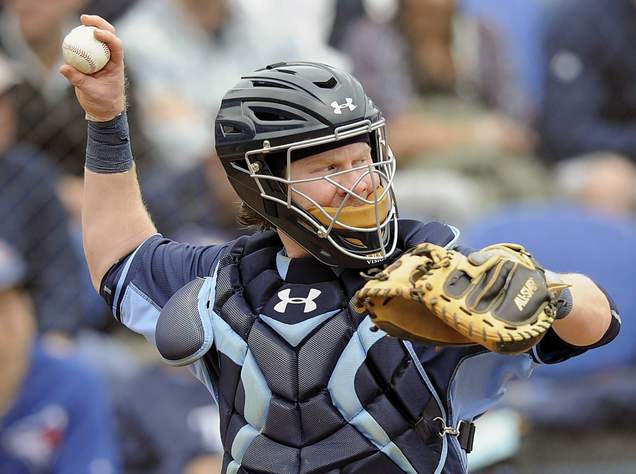Weighing RISK
Every play in baseball has a risk, whether it’s a choice of pitch, decision to swing, or which base to go with a fielded ground ball. As a catcher, you must be cautious as the risks of a play increase. However, as is often the case, the reward has great potential to outweigh the risk. Just think of how many baseball plays have risks that are associated with them: an attempt to pick off a runner from first base, a throw to second base in a first and third steal situation, intentionally low curveballs… the list could could go on. We will be covering the listed cases and game conditions that influence the amount of risk:
- Score
- Inning
- Runner’s abilities
- Catcher’s abilities
- Tendencies of the particular game
- Count on the batter
- Type of pitch
- Pitcher’s control
Score
In a close game, the risk and reward are high. Getting the runner or batter out could mean a win, but there is no guarantee. A bad throw or pitch could mean a loss. In a game where the score is not close, there is more room for risk, especially if you’re the team way behind. That risky play could put you back in the game.
Inning
There is less risk earlier in a game because there is still time to correct, as there is nine innings in a game. Later in the baseball game, the risk increases. By the time it is the ninth inning, a risky play could cost your team the game.
Runner’s abilities
The jump and speed of the runner factors in and may discontinue the play. This should be a factor in considering a different option; perhaps throwing to third rather than second.
Catcher’s abilities
How the catcher handles the pitch, specifically his speed of transfer to throwing hand and throwing accurary, will influence the decision to continue the play. There is no reason to make a late throw to second and allow the runner at third to score. However, giving up second base each time in that situation is not always the best decision, even if there is some risk attached.
Pitcher’s control
The pitch location may be critical in completing the play. The catcher may continue only if the pitch can be easily handled. A well thrown pitch, even if it’s not a strike, is a key factor in reducing risk.
Tendencies of a particular game
A play that has been attempted recently may influence the decision. Pitching-out, throwing to third and curveballs in the dirt every time can increase risk and thus reduce success.
Count on the batter
The count on the batter can influence the play called. Can we afford a pitch-out or a ball in the dirt in this case? If there is no play, we wasted a pitch and increased the chance of a play on the next pitch.
Type of pitch
Besides the pitch-out, the fastball is the best pitch to throw; but an alert base runner may decide not steal on that pitch. It may be more important to strike the batter out than waste a pitch anticipating a play.
Now, we are ready for the three level decision process: Evolving game conditions, Pitch-to-Pitch conditions and Instantaneous GO/NOGO.
I. Evolving game conditions: These are more gradual to change. These include the inning, abilities of runners, catchers, pitchers and substitute players.
II. Pitch-to-Pitch conditions: After each pitch, consider the score, count, tendencies, and type of pitch.
III. Instantaneous decision on that pitch: These decisions are based on the runner’s jump and ball control. If infielders are covering the bases, the decision can change from GO to NO GO.
Considering Steps I and II will allow us to make the decision whether to attempt the play. Then, Step III tells us if we will complete the play.
Interested in stepping up your baseball game with more tips like these? Check out our baseball resources to get tips for your favorite sport as soon as they are written!
How useful was this post?
Click on a star to rate it!
Average rating 0 / 5. Vote count: 0
No votes so far! Be the first to rate this post.



